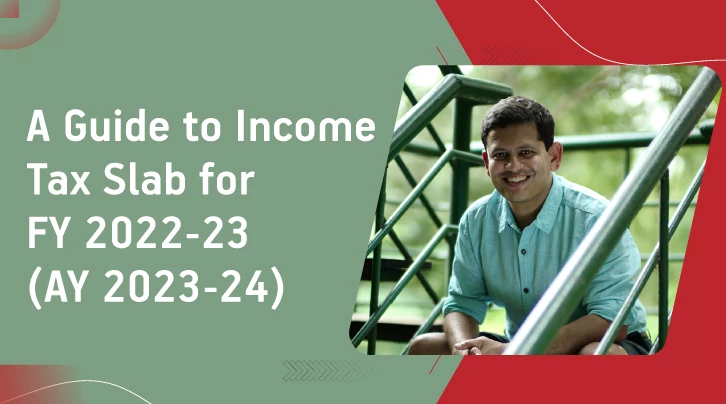Should you switch to the new taxation regime or compute your income tax as per the older regime? Check out this post to learn more about the tax slabs for FY 2022-23 (AY 2023-24) and how the new regime differs from the older one.
For FY 2022-23 (AY 2023-24), individual taxpayers can select between the new and old tax regimes. As there are some significant differences between the two, it is essential for taxpayers to thoroughly understand both tax regimes to make an informed decision.
Income Tax Slabs
Let’s take a look at the income tax slab for 2022-23 FY or AY 2023-23 and understand how the new tax regime is different from the older regime.
The income tax slab rates is different between individuals, senior citizens, and super senior citizens.
Individuals
Here are the income tax slab rates for individual taxpayers below 60 years as per the old and new tax regimes-
Net Taxable Income |
Slab Rate for FY 2022-23
(Old Regime) |
Slab Rate for FY 2022-23
(New Regime) |
Up to ₹2,50,000 |
NIL |
NIL |
₹2,50,001 to ₹5,00,000 |
5% |
5% |
₹5,00,001 to ₹7,50,000 |
20% |
10% |
₹7,50,001 to ₹10,00,000 |
20% |
15% |
₹10,00,001 to ₹12,50,000 |
30% |
20% |
₹12,50,001 to ₹15,00,000 |
30% |
25% |
₹15,00,001 and above |
30% |
30% |
Senior Citizens (60 to 79 Years)
Senior taxpayers are individuals between 60 to 80 years. Under the older regime, senior taxpayers have an exemption limit of up to ₹3,00,000, while it is up to ₹2,50,000 for individuals below 60 years. However, you’ll have to forego the higher tax exemption limit if you select the newer tax regime. Take a look-
Net Taxable Income |
Slab Rate for FY 2022-23
(Old Regime) |
Slab Rate for FY 2022-23
(New Regime) |
Upto ₹2,50,000 |
NIL |
NIL |
₹2,50,001 to ₹3,00,000 |
NIL |
5% |
₹3,00,001 to ₹5,00,000 |
5% |
5% |
₹5,00,001 to ₹7,50,000 |
20% |
10% |
₹7,50,001 to ₹10,00,000 |
20% |
15% |
₹10,00,001 to ₹12,50,000 |
30% |
20% |
₹12,50,001 to ₹15,00,000 |
30% |
25% |
₹15,00,001 and above |
30% |
30% |
Super Senior Citizens 80 years and above
Super seniors are individual taxpayers who are 80 years or older. As per the income tax slab for FY 2022-23 under the older regime, super seniors have an exemption limit of up to ₹5,00,000. But with the new taxation regime, the exemption limit is up to ₹2,50,000. Take a look-
Net Taxable Income |
Slab Rate for FY 2022-23
(Old Regime) |
Slab Rate for FY 2022-23
(New Regime) |
Up to ₹2,50,000 |
NIL |
NIL |
₹2,50,001 to ₹5,00,000 |
NIL |
5% |
₹5,00,001 to ₹7,50,000 |
20% |
10% |
₹7,50,001 to ₹10,00,000 |
20% |
15% |
₹10,00,001 to ₹12,50,000 |
30% |
20% |
₹12,50,001 to ₹15,00,000 |
30% |
25% |
₹15,00,001 and above |
30% |
30% |
Surcharge
Surcharge should be levied on the Income-tax payable amount before cess is levied. The surcharge rates are as follows:
Income range |
Surcharge rate |
Up to Rs. 50 lakhs |
NIL |
Exceeding Rs. 50 lakh but up to Rs. 1 crore |
10% |
Exceeding Rs. 1 crore but up to Rs. 2 crore |
15% |
Exceeding Rs. 2 crore but up to Rs. 5 crore |
25% |
Exceeding Rs. 5 crore |
37% |
Surcharge on capital gains on sale of equity shares, equity oriented mutual funds and dividend income should not exceed 15%.
Health and Education Cess
Taxpayers must also pay health and education cess at 4% beyond their income tax liability, irrespective of whether they use the old or new tax regime. Cess is calculated on total of tax payable and surcharge amount.
Key Differences Between New and Old Tax Regimes
The older income tax regime has a more complex structure due to the availability of several exemptions/deductions. As a result, in her Budget 2020 speech, Finance Minister Nirmala Sitharaman introduced a new tax regime with fewer exemptions/deductions and reduced tax rates to simplify the tax structure.
Compared to the older tax regime, the newer regime has two significant differences-
1. As can be seen in the tables above, the new taxation regime has more income tax slabs with reduced tax rates. So, the income tax slab for AY 2022-23 and AY 2023-24 vary depending on the tax regime you select.
2. As the tax rates have been reduced for various tax slabs in the new regime, taxpayers can no longer claim exemptions/deductions, like under Chapter VI-A of the income tax act, which includes popular deductions, especially under sections 80 including 80C, 80D, 80E, etc. However, some exemptions and deductions, like Section 80CCD(2), are also available in the new regime.
What Should You Choose Between Old and New Tax Regime for FY 2022-23 (AY 2023-24)?
Both the old and new tax regimes for FY 2022-23 have pros and cons. The selection between the two depends on several factors, including your net taxable income, tax-saving investments, and overall financial plan. Some individual taxpayers can reduce their tax liability with the newer regime, while others could benefit more with the older regime.
So, if you are confused with the tax rates for AY 2022-23 under the old and new regime and struggling to make a decision, it’d be wise to consult a professional tax advisor. Based on your tax profile, the advisor would be able to provide the correct guidance.
Click Here to learn about the ITR Meaning
Mutual Fund investments are subject to market risks, read all scheme related documents carefully.





 1800-270-7000
1800-270-7000




